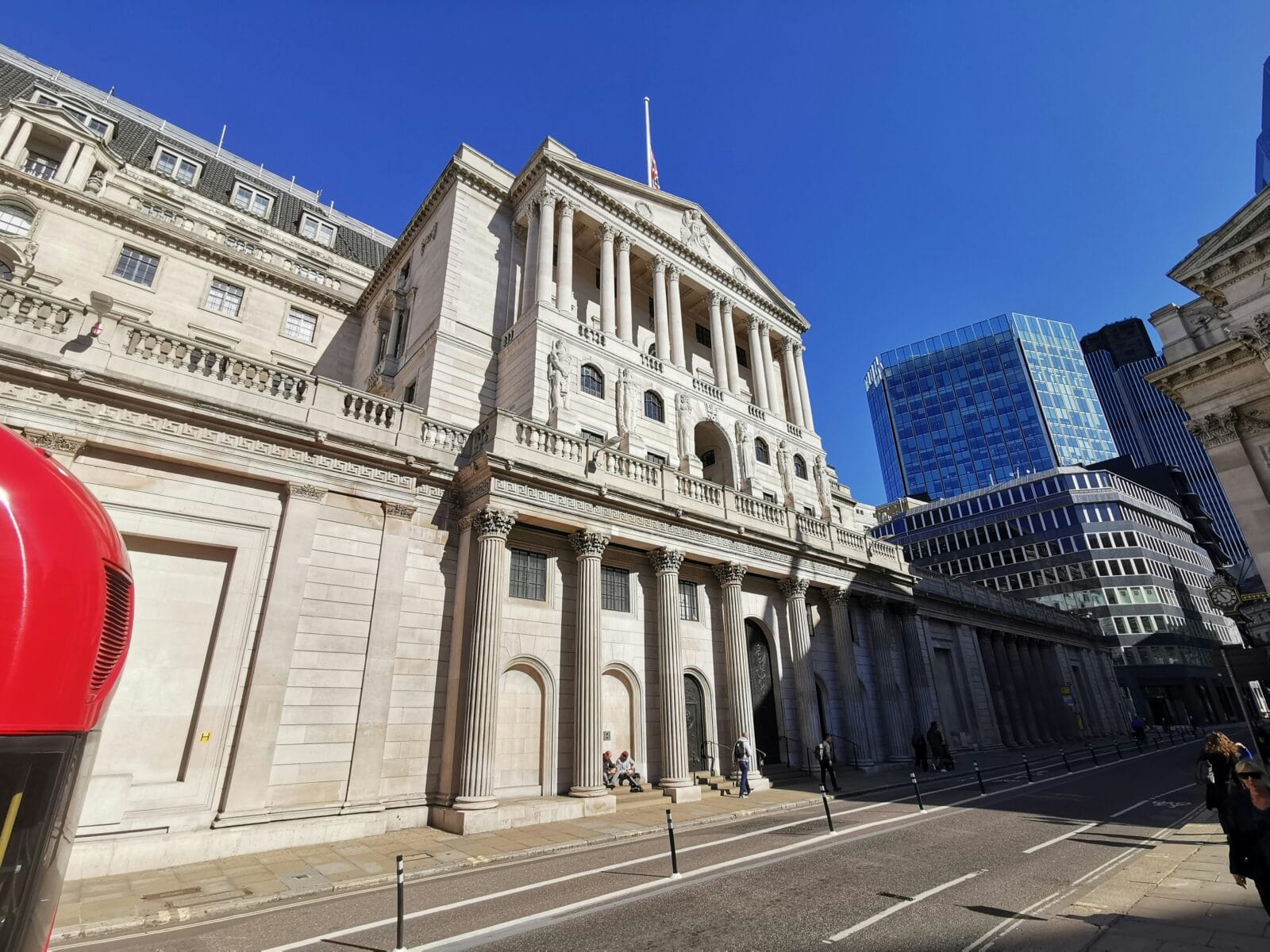In a widely anticipated decision, the Bank of England’s Monetary Policy Committee (MPC) has announced a reduction in the UK’s key interest rate from 4.75% to 4.5%. The move comes as the Bank responds to concerns over slowing economic growth as opposed to inflation concerns.
Looking ahead, analysts expect further quarter-point rate cuts throughout 2025. However, today’s focus is not just on rates but also on the Bank’s updated GDP forecast for the year ahead also published today—a key indicator for investors and businesses alike. The FTSE 100 hit an all-time high this morning, in anticipation of the interest rate decision.
Financial experts across the industry have been quick to react to this latest decision. Here’s what they’re saying:
Commenting on the latest Bank of England interest rate decision, Abhi Chatterjee, Chief Investment Strategist at Dynamic Planner said:
“On the back of lower growth forecasts, the Bank of England cut the benchmark rates by 25bps to 4.5%, its third rate cut in six months, with two of the rate setters advocating a steeper 50bps cut. The growth forecasts for the UK have been pared back to just 0.75% from 1.5% this year by the central bank. In addition, the bank also warned that inflation could reach a fresh peak of 3.7%, putting the 2% target out of reach.
“While the markets are estimating the possibility of four rate cuts this year, there is a sense that that would be premature, as inflation has proved stickier than expected. Given US trade policies around tariffs as well as perceived inflationary influence of the current Budget, the fight against inflation seems far from over.
“Given the possibility of the UK entering stagflation, pursuing growth at the cost of inflation seems to be the preferred option for the central bank, not to mention the incumbent government. As the uncertainty around the future of growth in the UK increases, policymakers face a dwindling number of options to stimulate economic growth.”
Jonny Black, Chief Commercial & Strategy Officer at abrdn adviser, said: “Today’s decision to cut the base rate comes as no surprise, with many predicting this move after better-than-expected inflation figures and a drive to accelerate economic growth. It also aligns with Andrew Bailey’s comments late last year about rate reductions being on the horizon.
“For savers, it’s a reminder to reassess how and where their money is working hardest. Whether it’s planning a major financial decision or looking to adjust a regular savings strategy, now is a good time for people to review their options including whether non-cash alternatives are suitable for them. Financial advisers will continue to play a critical role in helping to navigate this environment and market volatility.”
Sarah Pennells, Consumer Finance Specialist at Royal London comments: “The Bank of England’s decision to reduce the base rate to 4.5% will be welcome news to both borrowers with a variable rate mortgage and prospective buyers. While the cost of living crisis has receded, higher bills – including housing costs – continue to cause pain.
“Our latest research shows that one in five people don’t manage to get to the end of the month without going overdrawn, either every month or from time to time, rising to over one in four mortgage borrowers (27%) and three in ten (30%) renters. Fewer than half of UK adults say they have any money left over at the end of the month once they’ve paid their bills.
“The vast majority of mortgage borrowers are on a fixed rate mortgage, and we know that other factors, not just the base rate, have an impact on the competitiveness of fixed rate deals. However, those who are on a variable rate mortgage will benefit from a reduction in their monthly mortgage payments. According to our research mortgage borrowers only saw a reduction of £4 a month in housing costs on average, compared to a year earlier, with almost four in ten telling us they were spending more.”
Mike Randall, CEO at Simply Asset Finance, says: “Businesses up and down the country will be breathing a sigh of relief with rates ticking downward. Not only will it give some much needed breathing space for those squeezed by the NI rise; those eager to grow will find borrowing cheaper. Combined with the recent publishing of the Governments’ growth strategy, the outlook for 2025 is looking much more positive.
“But with Trump-led trade wars perhaps tempering the speed of future cuts, the Government cannot afford to take its eye off the ball when it comes to creating an environment that enables domestic growth to flourish.”
Brad Holland, director of investment strategy at J.P. Morgan owned digital wealth manager, Nutmeg, said: “Buoyed by falling inflation, Bank of England policymakers have cut the bank rate to its lowest level since June 2023. The Bank of England is chiselling away at interest rates as evidence mounts that upwards wage pressure will dissipate over the next 12 months.
“Looking longer term, there is still work to be done to find the ‘neutral’ level for rates where the UK economy can deliver price stability. As a result, the committee remains in monitoring mode, assessing the impact of rate cuts on growth and how recent measures taken in the Autumn Budget could impact inflation. Andrew Bailey also has one eye on the global picture with geopolitical conflicts and trade tensions posing a risk to the UK economy. These factors all combine to create an air of uncertainty around the UK economy in 2025.
“For now, even at 4.5%, the bank rate is well above what might be considered the neutral level, and we expect the committee to stay its course of gradually removing monetary policy restraint. Money markets are pricing in a further two to three rate cuts this year, but events could quickly change this.”
Lindsay James, investment strategist at Quilter Investors: “In a sign that the UK economy is looking increasingly fragile, even as inflation remains at palatable levels, the Bank of England has responded by lowering interest rates to 4.5%. The BoE’s prediction that inflation peaks at 3.7% in Q3 this year is quite shocking given previous forecasts and certainly won’t be helped by the April hike in minimum wages or higher National Insurance contributions on employers. So much so the previously expected pickup in growth this year is quickly becoming wishful thinking, however this remains the Bank’s key focus. Hiring has remaining subdued, whilst data from the service economy has highlighted that the pace of job cuts has accelerated to its fastest in four years as wage growth continues to outpace inflation.
“With supply chains passing on employment cost increases to the end customer, this is likely to put upward pressure on inflation in the coming months but will also put profit margins under pressure as consumers are likely to resist paying more.
“Whilst the economic picture has undeniably worsened in recent months, so too pockets of optimism remain. With wage growth so strong but sentiment weak, consumers have been rebuilding savings that will at some point be released into the economy, whilst the housing market continues to look resilient and further support will come from the two or three quarter point cuts to the base rate expected by the end of the year.
“The UK’s issue with productivity and growth will not be solved overnight, however, and as such the government must rely on the Bank of England to stimulate the economy. But, this all takes time to feed through and thus all adds up to the most likely outcome being yet more low, anaemic, growth rather than recession.
“For investors, this situation does present somewhat of a silver lining. With expectations already so low, UK equities, which have outshone the returns from the US year to date, continue to earn their place in portfolios.”
Helen Vieira, Head of Banks at Flagstone International said: “The Bank of England’s decision to lower the base rate continue to signal this turning point in UK monetary policy, as inflation continues to moderate and economic growth remains subdued. With the base rate reduced from 4.75%, the MPC acknowledges the easing of price pressures and aims to support consumer spending and business investment. This move is expected to provide relief to borrowers and stimulate growth across key sectors
For international cash depositors, a rate cut marks the moving shift towards a lower interest rate environment, which could impact returns in the coming months. This means that depositors need to stay up to date to ensure that they are maximising their yields. However, with global markets still adjusting to varying central bank policies, opportunities remain for those who actively manage their cash to secure optimal returns across multiple jurisdictions.”
Lily Megson, Policy Director at My Pension Expert said: “This was an eagerly anticipated decision, and a cut to the base rate will no doubt be celebrated as good news. But we’ve been here before, and if last year taught us anything, it’s that fleeting economic shifts cannot overshadow the need for long-term financial planning.
“For many Britons, a lower cost of borrowing is positive, but the flip side is that lower interest rates will mean challenges for savers, especially those nearing retirement. Indeed, we should expect many retirement planners to now question whether their strategy and financial products still serve their interests. However, without reliable support, these questions can be hard for people to answer.
“That’s where the government must step in and do much, much more. We’ve heard plenty of rhetoric about pension reforms designed to both boost the economy and provide better outcomes for savers. But now is the time for decisive action – the government has to turn promises into policy, with a particular focus on improving access to financial education and independent advice. Only then will all retirement planners be able to make informed financial decisions and navigate events like today’s base rate cut with greater confidence.”
Giles Hutson, CEO and co-founder of Insignis, comments: “Today’s decision to cut the base rate to 4.5% comes as little surprise, given sluggish UK growth and the likelihood of a short-term uptick in inflation. This marks the third reduction since the Bank began loosening policy in August last year, but the key question for savers now is where the rate will settle, and what that means.
With central banks potentially tolerating inflation between 2.5% and 3% to balance growth and debt challenges, the path ahead for interest rates remains uncertain. In this shifting landscape, proactive cash management is key. Cash remains a steadfast asset class, providing a buffer in times of economic uncertainty – particularly with mounting geopolitical headwinds. With savings rates still attractive, and clients are increasingly choosing longer-term fixed rates to make the most of their cash.”















